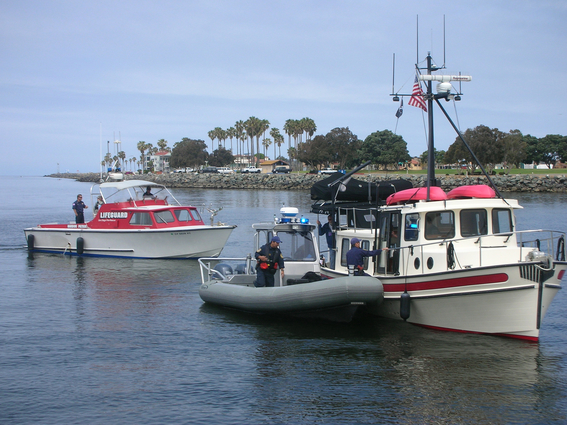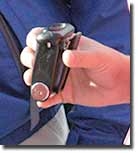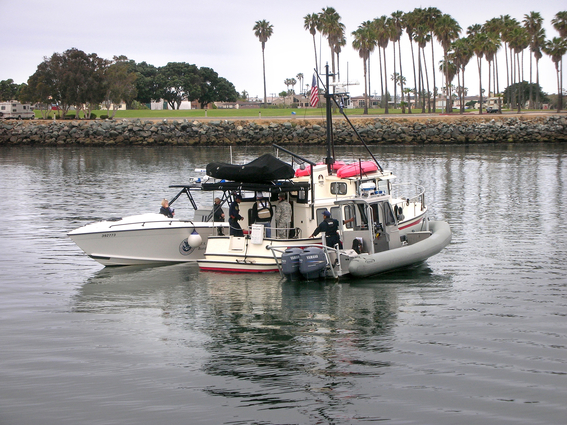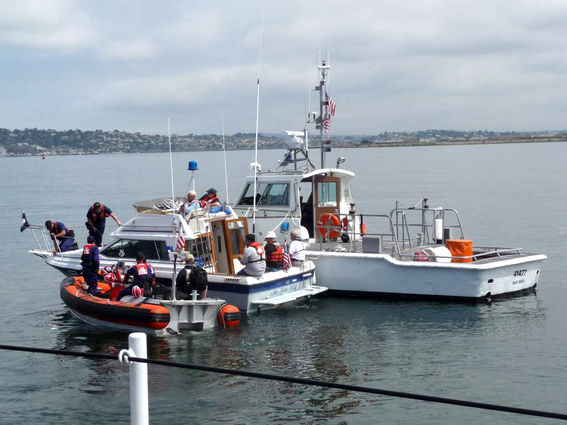LLNL aids in maritime exercise to screen small vessels for radiological cargo
SAN DIEGO, CALIF. — More than 130 trained maritime law enforcement and first responder personnel from federal, state, and local agencies participated in an operational maritime exercise in San Diego as part of a larger state of California Golden Guardian 2010 exercise on May 18.
The exercise consisted of three separate operations. Maritime law enforcement and first responders conducted small vessel radiological screenings at two security zones in San Diego Bay and Mission Bay.
The exercise is part of the West Coast Maritime Pilot Program funded by the Department of Homeland Security (DHS) Domestic Nuclear Detection Office (DNDO) to evaluate radiation detection sensors and operational protocols for the small vessel maritime environment. The pilot directly supports the DHS Small Vessel Security Strategy, which serves to reduce potential security and safety risks on the nation’s waterways and ports. Small vessels are considered watercraft under 300 gross tons such as recreational boats, yachts and small commercial vessels.
San Diego was selected for the pilot demonstration because of its proximity to U.S. - Mexico international border, the presence of the largest Naval base on the west coast and home to five other major military bases, its high population density, the ease of access by small vessels, and the larger number of small vessels using San Diego waterways. In addition, San Diego has an existing Joint Harbor Operations Center (JHOC) that serves to coordinate the maritime activities of the Coast Guard, U.S. Navy, CBP, San Diego Harbor Police, and other law enforcement agencies.
Lawrence Livermore National Laboratory coordinated activities with DNDO, the U.S. Coast Guard, U.S. Customs and Border Protection (CBP), and many other state and local agencies.
Team members used portable hand-held radiation detection equipment to locate and identify industrial-type low-level radiation sources placed on small vessels as part of the exercise.
"Our exercise involved an intelligence-driven radiological/nuclear threat scenario, resulting in establishment of chokepoint screening operations at multiple locations, threat detection and interdiction, transfer of radiological data for analysis by onshore subject matter experts, transfer of analysis results back to on-scene law enforcement personnel in support of incident adjudication, and response activities associated with identified threats," said LLNL West Coast Maritime Pilot Project Manager Craig Wuest.
LLNL’s Drew Casavant, exercise director and deputy project manager said, "The exercise allowed us to operationally assess advanced technology systems and protocols in a realistic operational maritime setting. The ultimate goal is to provide the ability for DHS and regional partners to prevent illicit radiological or nuclear materials from entering local waterways by way of small vessels." DNDO has invested $8 million in equipment, training, drill, and exercise support for state and local personnel in preventive radiological detection for the San Diego pilot.
During the past year, LLNL has worked closely with DNDO to coordinate with various federal, state and regional maritime partners to provide guidance on operational protocols, equipment, equipment training and exercise and drill development.
While authorities stress that no known current threat exists, the exercise did provide DNDO and its partners a chance to conduct operations under real world conditions. The partnering agencies assessed the geographic layout of the bays and waterways and designed a method to maximize detection and interdiction opportunities.
"The Full Scale Exercise provided a tool to evaluate capabilities fielded through the West Coast Maritime Pilot and to collect information that will inform decisions on expanding these capabilities across the United States. The exercise helped identify improvements we can make to further enhance our ability to reduce risks in the maritime pathway. Importantly, it demonstrated a successful integration of efforts across a wide array of Federal, State, and local agencies supporting the critical preventive radiological and nuclear detection mission." said DNDO Pilot Director Chris Inman.
In September 2007, DNDO announced the creation of a three-year West Coast Maritime Pilot program. It provided an opportunity for state and local authorities in the San Diego area, and in Washington's Puget Sound, to better understand the current prevention and detection capabilities and to develop a concept of operations on how to detect and interdict potential threats on small vessels. It also led to improved cooperation and interaction among various federal, state and regional maritime, technical and law enforcement entities.
Pilot participants included: the U.S. Coast Guard (Sector San Diego and Maritime Safety and Security Team), U.S. Customs and Border Protection (Office of Air and Marine Operations, Office of Field Operations), Federal Bureau of Investigation, San Diego Area Maritime Security Committee, San Diego Harbor Police, California Department of Fish and Game, California National Guard (9th Civil Support Team), San Diego County Hazardous Incident Response Team (HIRT), City of San Diego Fire and Rescue Department (Lifeguard Service and HIRT), City of San Diego Police Department.
Participating technical reachback agencies included: the San Diego County Department of Environmental Health, California Department of Public Health Radiologic Health Branch, CBP Laboratories and Scientific Services, and DNDO’s Joint Analysis Center.
Other exercise boat providers/operators included: the U.S. Coast Guard Auxiliary, DHS Science and Technology Testbed at San Diego State University, Los Angeles County Sheriff’s Department, and the San Diego Harbor Police Retired Service Volunteer Program.
Founded in 1952, Lawrence Livermore National Laboratory is a national security laboratory that develops science and engineering technology and provides innovative solutions to our nation’s most important challenges. Lawrence Livermore National Laboratory is managed by Lawrence Livermore National Security, LLC for the U.S. Department of Energy’s National Nuclear Security Administration.
Contact
Bob Hirschfeld[email protected]
925-422-2379
Related Links
DHS announces West Coast maritime radiation detection projectDHS Domestic Nuclear Detection Office
SAFE Port Act: Status of Implementation One Year Later
San Diego Fire/Rescue Dept.
San Diego Joint Harbor Operations Center








